2019-02-07 - Nº 197

Editorial
Esta é a Newsletter Nº 197 que se apresenta com o mesmo formato que as anteriores. Se gostar da Newsletter partilhe-a!
Todas as Newsletters encontram-se indexadas no link.
Esta Newsletter tem os seguintes tópicos:
Faz hoje anos que nascia, em 1804, John Deere. Este norte-americano foi pioneiro na invenção e fabrico de equipamentos agrícolas. Como ferreiro numa cidade de pradarias nos EUA, ele fazia frequentemente reparações nos arados de madeira e ferro fundido do leste dos EUA porque os solos locais eram pesados e pegajosos. Em 1838, ele produziu mais três arados de aço adequados para o seu novo projecto, e mais nos anos seguintes, que se expandiram para o negócio de máquinas agrícolas que ele começou a mudar para Moline, Illinois (1847). Noutros dez anos, a sua produção anual aumentou dez vezes. Originalmente usando aço inglês importado em vez de ferro fundido, ele converteu-se ao aço produzido nos EUA quando as siderurgias de aço de Pittsburgh puderam fornecer um produto adequado. A empresa diversificou com a produção de grades, brocas, cultivadores e vagões.
Faz igualmente anos hoje que nascia, em 1877, G. H. Hardy. Este matemático inglês ficou conhecido pelo seu trabalho na teoria dos números e análise matemática. Os interesses de Hardy cobriam muitos tópicos de matemática pura - análise diofantina, somatória de séries divergentes, séries de Fourier, a função zeta de Riemann e a distribuição de primos. Embora Hardy se considere um matemático puro, no início de sua carreira, ele ainda trabalhou em matemática aplicada quando formulou uma lei que descreve como proporções de características genéticas dominantes e recessivas se propagam em uma grande população (1908). Hardy considerou que não é importante, mas provou ser de grande importância na distribuição de grupos sanguíneos. Como também foi descoberto independentemente por Weinberg, e é conhecido como o princípio de Hardy-Weinberg.
Por fim, faz anos hoje que nascia, em 1926, Konstantin Feoktistov. Este Cosmonauta e engenheiro espacial russo ficou conhecido por, a partir de 1955, fazer parte da equipa que projetou as naves espaciais Sputnik, Vostok, Voskhod e Soyuz sob a liderança de Sergey Korolev. Ele treinou como um cosmonauta, e finalmente foi lançado a 12 de Outubro de 1964 para 16 órbitas terrestres como um dos tripulantes de Voskhod 1 (com Vladimir M. Komarov e Boris B. Yegorov), o primeiro voo espacial multi-manto do mundo. Apenas dez pessoas estavam em órbita antes da missão Voskhod 1. Quando a sua carreira como cosmonauta terminou por razões médicas, ele continuou como engenheiro espacial tornando-se chefe do departamento de design espacial soviético que projetou as estações espaciais Salyut e Mir.
Nesta semana que passou ficámos a saber que o Norte magnético da Terra está a deslocar-se rapidamente do Ártico canadiano em direcção à Sibéria. Normalmente, uma versão nova e atualizada do World Magnetic Model (WMM) é lançada a cada cinco anos. Com o último lançamento em 2015, a próxima versão está prevista para lançamento no final de 2019. Devido a variações não planeadas na região do Ártico, os cientistas lançaram um novo modelo para representar com mais precisão a mudança do campo magnético entre 2015 e agora. Esta actualização fora de ciclo antes do lançamento oficial do WMM2020 no próximo ano garantirá navegação segura para aplicações militares, companhias aéreas comerciais, operações de busca e salvamento e outras que operam em torno do Polo Norte.
Na Newsletter desta semana apresentamos diversos projetos de maker.
 João Alves ([email protected])
João Alves ([email protected])
O conteúdo da Newsletter encontra-se sob a licença  Creative Commons Attribution-NonCommercial-ShareAlike 4.0 International License.
Creative Commons Attribution-NonCommercial-ShareAlike 4.0 International License.
Novidades da Semana

World Magnetic Model Out-of-Cycle Release
"Earth’s northern magnetic pole is moving quickly away from the Canadian Arctic toward Siberia. This movement has forced NCEI’s scientists to update the World Magnetic Model (WMM) mid-cycle. Typically, a new and updated version of the WMM is released every five years. With the last release in 2015, the next version is scheduled for release at the end of 2019. Due to unplanned variations in the Arctic region, scientists have released a new model to more accurately represent the change of the magnetic field between 2015 and now. This out-of-cycle update before next year’s official release of WMM2020 will ensure safe navigation for military applications, commercial airlines, search and rescue operations, and others operating around the North Pole." [...]
Outras Notícias

Mbed OS 5.11.3 released
"We are pleased to announce the Mbed OS 5.11.3 release is now available. This is the latest patch release based on the feature set that Mbed OS 5.11 introduces. Summary In this release we have added target support for Quectel M26 GSM/GPRS module and C030-R412M, We have added fixes for the following reported issues: 9138 Can't execute OS2 tests in ARM if default_toolchain is uARM 85 Len vs amount check 9400 tests-mbedmicro-rtos-mbed-systimer to tune ? 9426 NUCLEO_H743ZI: iar export failing 9281 lfs_emubd.c needs to be ignored? 9513 Occasional hard fault when using the mbedtls entropy function in parallel threads (K64F) Support has been added for: nanostack on KW41Z an updated PSA binaries importer for FUTURE_SEQUANA_PSA FLASH on TARGET_MAX32620C MCU, MAX32620FTHR and SDT32620B CAN on STM32H7 TICKLESS on NUCLEO_H743ZI QSPIF as default storage for LPCXpresso546XX Important notes: A folder path fix for KVStore FILESYSTEM configuration and default configuration (under SD component) has been added. Previously the folder path was the constant "kvstore"." [...]
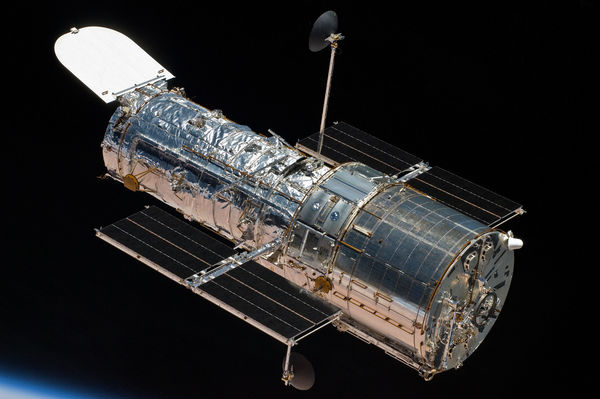
Hubble's Most-Used Camera is Back in Action After a Strange Malfunction
"The Hubble Space Telescope’s Wide Field Camera 3 is once again operational after issues earlier this month caused the camera to suddenly stop observations. On Jan. 8, the telescope’s camera abruptly stopped working when it detected voltage levels outside of the expected range. That set engineers searching for what caused the problem. After investigating the issue, the team ended up finding that the voltage levels inside the camera were actually normal. Instead, data in the instrument’s telemetry circuits wasn’t accurate. And all of the instrument’s other telemetry circuits also had bad data." [...]
Ciência e Tecnologia

Unmanned Vehicles to Take Quantum Leap
"Quantum sensors being developed at The University of Queensland could revolutionise navigation and communications in unmanned and autonomous vehicles. UQ researchers are working with the Australian Defence Force (ADF), NASA, Orica Ltd and Brisbane’s Skyborne Technologies to develop the next-generation sensors as part of a $6.6 million Australian initiative to develop quantum technologies for use in defence applications. UQ scientist Professor Warwick Bowen said the research could position Australia as a world-leader in ultraprecise sensors for unmanned and autonomous vehicles. “This is an exciting new direction, applying quantum physics to major challenges in modern technology,” he said. “Quantum sensors allow greatly improved performance and could transform navigation and positioning capabilities for unmanned vehicles. “These sensors will be so precise that the laws of quantum physics are required to understand how they function." [...]

Building Trusted Human-Machine Partnerships
"A key ingredient in effective teams – whether athletic, business, or military – is trust, which is based in part on mutual understanding of team members’ competence to fulfill assigned roles. When it comes to forming effective teams of humans and autonomous systems, humans need timely and accurate insights about their machine partners’ skills, experience, and reliability to trust them in dynamic environments. At present, autonomous systems cannot provide real-time feedback when changing conditions such as weather or lighting cause their competency to fluctuate. The machines’ lack of awareness of their own competence and their inability to communicate it to their human partners reduces trust and undermines team effectiveness. To help transform machines from simple tools to trusted partners, DARPA today announced the Competency-Aware Machine Learning (CAML) program. CAML aims to develop machine learning systems that continuously assess their own performance in time-critical, dynamic situations and communicate that information to human team-members in an easily understood format." [...]

Computational algorithm to reduce electromagnetic noise in electronic circuits developed
"In order to design noiseless electromagnetic (EM) devices, it is necessary to clarify the mechanism behind EM noise and theoretical calculations and computer simulations are performed for prediction assessment of devices. Two researchers at Osaka University developed an algorithm for numerical calculation of EM noise (interference) in electric circuits. EM noise is a problem that has proven to be difficult to solve. Caused by interference from transmission lines and connecting parts, various approaches have been taken to reduce it, such as adding filters and/or passive devices to circuits or using the symmetry of the configuration. The algorithm developed in this study is for computer simulation of electric circuits in which transmission lines are connected with lumped element models. Usually, the solution of problems along a transmission line is performed using partial differential equations, while the solution of problems in a lumped constant circuit uses ordinary differential equations." [...]
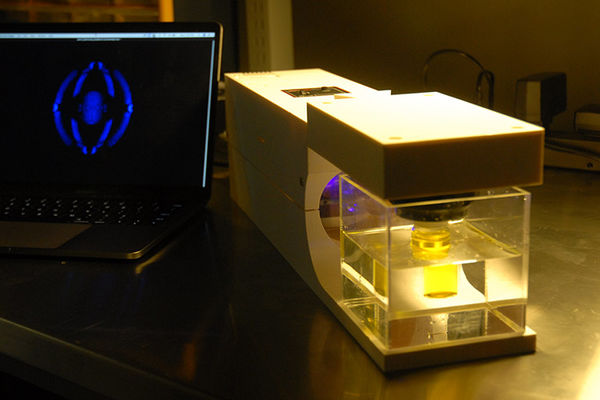
New 3D printer uses rays of light to shape objects, transform product design
"A new 3D printer uses light to transform gooey liquids into complex solid objects in only a matter of minutes. Nicknamed the “replicator” by the inventors — after the Star Trek device that can materialize any object on demand — the 3D printer can create objects that are smoother, more flexible and more complex than what is possible with traditional 3D printers. It can also encase an already existing object with new materials — for instance, adding a handle to a metal screwdriver shaft — which current printers struggle to do. The technology has the potential to transform how products from prosthetics to eyeglass lenses are designed and manufactured, the researchers say. “I think this is a route to being able to mass-customize objects even more, whether they are prosthetics or running shoes,” said Hayden Taylor, assistant professor of mechanical engineering at UC Berkeley and senior author of a paper describing the printer, which appears online today (Jan. 31) in the journal Science. “The fact that you could take a metallic component or something from another manufacturing process and add on customizable geometry, I think that may change the way products are designed,” Taylor said." [...]

Neurocomputing lab creates 1st Russian neural network processor
"Engineers and researchers working under a project of the Russian Foundation for Advanced Research (FAR) — a government agency for defense research — has demonstrated the first Russian-made specialized neural network processor for energy efficient execution of machine learning algorithms based on deep neural networks. These algorithms are widely used to automatically solve tasks in image and speech recognition, self-driving car control, and elsewhere. The prime contractor of the project is the Neurocomputing Systems Lab of the Moscow Institute of Physics and Technology. Machine learning algorithms that rely on deep neural networks require considerable computing power, and they are typically run using graphics accelerators. The latter consume way too much power to be of use on a mobile platform, such as small unmanned aerial or ground vehicles or smart cameras. This is why researchers worldwide are pursuing the notion of specialized neural network tensor processors." [...]
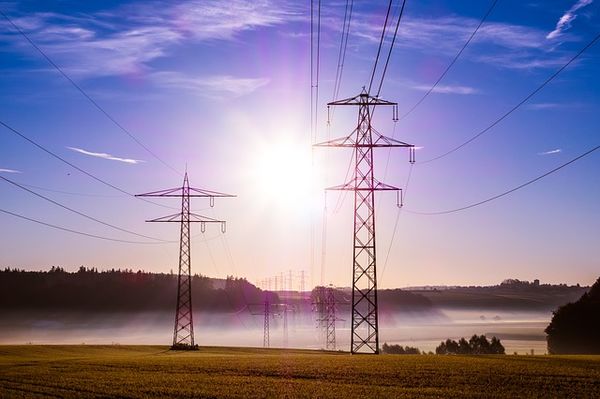
Hybrid electricity system would reduce rates, improve service
"A new distribution system designed by researchers at the University of Waterloo would reduce electricity prices by more than five per cent while also improving service reliability. The design involves the integration of the two kinds of electric current that power homes, industries and electric vehicles - alternating current (AC) and direct current (DC). Researchers found efficiencies by designing a system that delivers both kinds of current to customers instead of the AC-only distribution systems now in use throughout the world. Their approach minimizes conversions from one kind of current to the other and makes it easier to integrate growing green technologies. “Minimizing power conversion requirements creates a simpler system with greater efficiency and less loss,” said Haytham Ahmed, a postdoctoral fellow who led the research with electrical engineering colleagues at Waterloo. “As you reduce the number of converters, you also reduce the chances of service interruptions due to breakdowns.” Existing power networks carry AC because of the utilization of power transformers to increase voltage for greater long-distance transmission efficiency and reduce voltage for distribution purposes." [...]
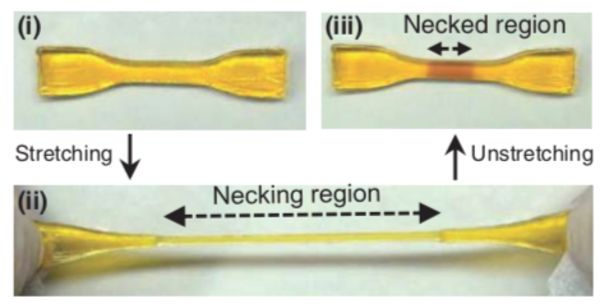
Self-growing materials that strengthen in response to force
"A strategy inspired by the process responsible for muscle growth could lead to the development of stronger, longer-lasting materials. Hokkaido University researchers have developed a strategy to fabricate materials that become stronger in response to mechanical stress – mimicking skeletal muscle growth. Their findings, published in the journal Science, could pave the way for long-lasting materials that can adapt and strengthen based on surrounding conditions. The strategy was inspired by the process that makes human skeletal muscles become stronger. As a result of strength training at the gym, for example, muscle fibres break down, encouraging the formation of new, stronger fibres. For this to happen, the muscles must be supplied with amino acids, the building blocks of proteins, which join together and form muscle fibres." [...]
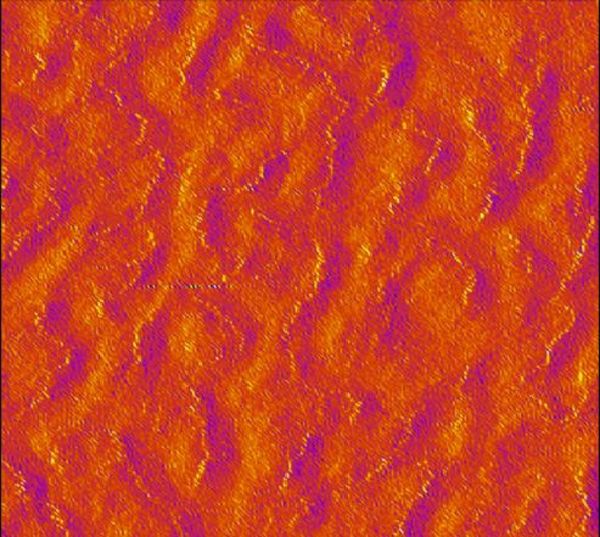
Graphene crinkles can be used as 'molecular zippers'
"New research shows that electrically charged crinkles in layered graphene can be useful in the directed self- assembly of molecules. PROVIDENCE, R.I. [Brown University] — A decade ago, scientists noticed something very strange happening when buckyballs — soccer ball shaped carbon molecules — were dumped onto a certain type of multilayer graphene, a flat carbon nanomaterial. Rather than rolling around randomly like marbles on a hardwood floor, the buckyballs spontaneously assembled into single-file chains that stretched across the graphene surface. Now, researchers from Brown University’s School of Engineering have explained how the phenomenon works, and that explanation could pave the way for a new type of controlled molecular self-assembly. In a paper published in Proceedings of the Royal Society A, the Brown team shows that tiny, electrically charged crinkles in graphene sheets can interact with molecules on the surface, arranging those molecules in electric fields along the paths of the crinkles. “What we show is that crinkles can be used to create ‘molecular zippers’ that can hold molecules onto a graphene surface in linear arrays,” said Kyung-Suk Kim, director of the Center for Advanced Materials Research in Brown’s Institute for Molecular and Nanoscale Innovation and the study’s senior author." [...]
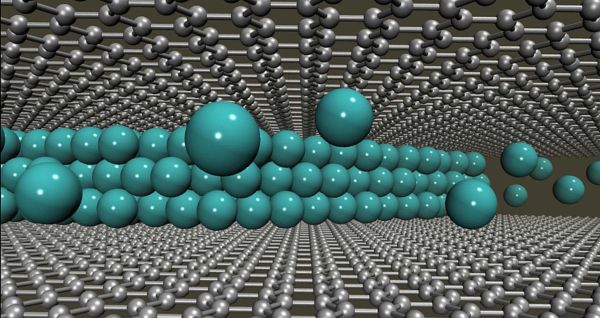
Supercomputing Helps Study Two-Dimensional Materials
"HPC helps researchers understand experiments for observing real-time motion of lithium atoms in bi-layer graphene, paving the way for designing new materials for batteries and other electronics. Whether it is high-temperature superconductors and improved energy storage to bendable metals and fabrics capable of completely wicking liquids, materials scientists study and understand the physics of interacting atoms in solids to ultimately find ways to improve materials we use in every aspect of daily life. The frontier of materials science research lies not in alchemical trial and error, though; to better understand and improve materials today, researchers must be able to study material properties at the atomic scale and under extreme conditions. As a result, researchers have increasingly come to rely on simulations to complement or inform experiments into materials’ properties and behaviours. A team of researchers led by Dr. Arkady Krasheninnikov, physicist at the Helmholtz-Zentrum Dresden-Rossendorf, partners with experimentalists to answer fundamental questions about materials’ properties, and the team recently had a big breakthrough—experimentalists were able to observe in real time lithium atoms’ behaviour when placed between two graphene sheets. A graphene sheet is what researchers consider a 2D material, as it is only one atom thick, which made it possible to observe lithium atom motion in a transmission electron microscopy (TEM) experiments." [...]
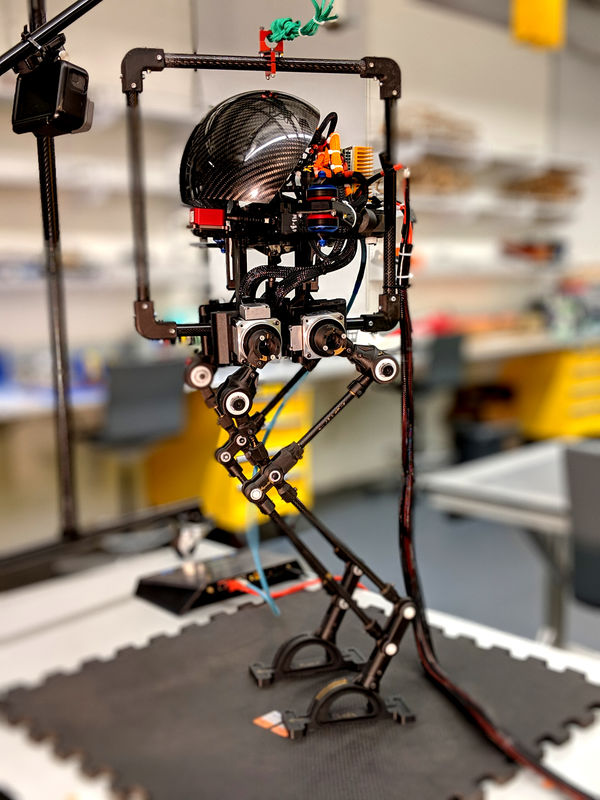
Some Robots Walk. Others Fly. He Built One That Can Do Both
"A bipedal robot walks on the surface of a distant planet. Its sensors scan the environment, sending data back to Earth. It comes to a crumbling hillside, flexes its knees and leaps, thrusters whirring, to land safely above the loose rock. This future is still a distant dream away, but Alireza Ramezani, an assistant professor of electrical and computer engineering at Northeastern, has brought it one step closer with a robot that he helped to build as a postdoctoral researcher at the California Institute of Technology. The robot is known as LEONARDO, an acronym for LEg ON Aerial Robotic DrOne, or Leo for short. It has a capability most robots these days just don’t have: It can both walk and fly." [...]

A reconfigurable soft actuator
"Mechanical systems, such as engines and motors, rely on two principal types of motions of stiff components: linear motion, which involves an object moving from one point to another in a straight line; and rotational motion, which involves an object rotating on an axis. Nature has developed far more sophisticated forms of movement — or actuation—that can perform complex functions more directly and with soft components. For example, our eyes can change focal point by simply contracting soft muscles to change the shape of the cornea. In contrast, cameras focus by moving solid lenses along a line, either manually or by an autofocus. But what if we could mimic shape changes and movements found in nature? Now, researchers at the Harvard John A. Paulson School of Engineering and Applied Sciences (SEAS) have developed a method to change the shape of a flat sheet of elastomer, using actuation that is fast, reversible, controllable by an applied voltage, and reconfigurable to different shapes." [...]

A new approach for the fast estimation of the solar energy potential in urban environments
"TU Delft researchers have developed a new approach for calculating fast and accurate the solar energy potential of surfaces in the urban environment. The new approach can significantly help architects and urban planners to incorporate photovoltaic (solar power) technology in their designs. The findings were presented on Monday 4 February in Nature Energy. Buildings, trees and other structures in urban areas cause shading of solar modules, which strongly affects the performance of a PV system. Accurate assessment of this performance, and the related price/performance of PV systems, will facilitate their integration in the urban environment. Computationally highly demanding Several tools are available for simulating the energy yield of PV systems." [...]
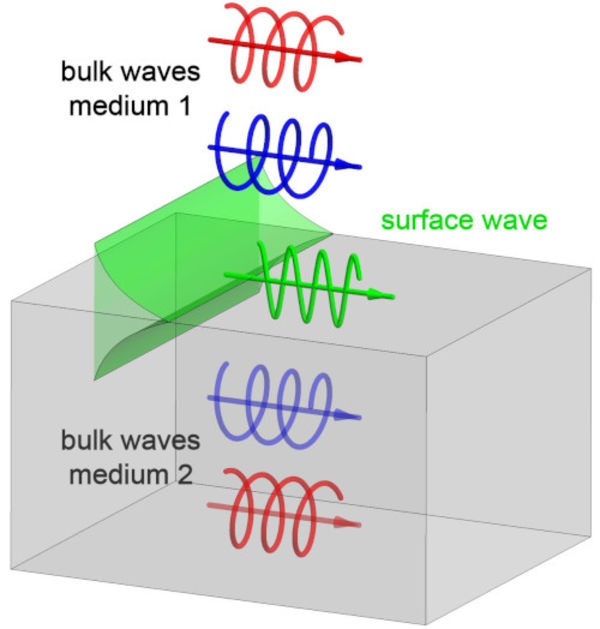
Physicists uncover the topological origin of surface electromagnetic waves
"Maxwell’s electromagnetic theory, which was formulated 150 years ago, was one of the greatest breakthroughs in physics. It united electricity and magnetism, provided an ultimate description of electromagnetic waves, including light, and anticipated relativity and the field theories of the 20th century. More recently, more than 60 years ago, scientists found that electromagnetic radiation can not only propagate in free space but can also form surface waves at interfaces between different media, such as between metals and air or glass. This resulted in the development of plasmonics and metamaterials, where surface electromagnetic waves underpin a number of phenomena and useful applications. Another area of modern physics where surface waves play crucial role is topological quantum systems, which are very robust against small perturbations and continuous deformations. The discovery of nontrivial topological phases in condensed-matter quantum systems and the existence of topological surface modes at interfaces between topologically-different materials resulted in the Nobel Prize in physics in 2016." [...]

Engineers program marine robots to take calculated risks
"Algorithm could help autonomous underwater vehicles explore risky but scientifically-rewarding environments. We know far less about the Earth’s oceans than we do about the surface of the moon or Mars. The sea floor is carved with expansive canyons, towering seamounts, deep trenches, and sheer cliffs, most of which are considered too dangerous or inaccessible for autonomous underwater vehicles (AUV) to navigate. But what if the reward for traversing such places was worth the risk? MIT engineers have now developed an algorithm that lets AUVs weigh the risks and potential rewards of exploring an unknown region. For instance, if a vehicle tasked with identifying underwater oil seeps approached a steep, rocky trench, the algorithm could assess the reward level (the probability that an oil seep exists near this trench), and the risk level (the probability of colliding with an obstacle), if it were to take a path through the trench." [...]
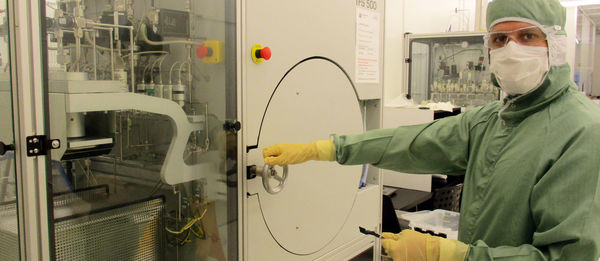
Breakthrough in photonics: data-transmitting light signal gets power boost from nanosized amplifier
"An international team of researchers from Aalto University and Université Paris-Sud has significantly improved the propagation of data inside a microchip. Light is a more energy efficient and faster way of transferring data than electricity. Until now, the rapid attenuation of light signals in microchips has prevented the use of light as a source of an information signal. With international collaboration, researchers at Aalto University have now developed a nanosized amplifier to help light signals propagate through microchips. In their study published in Nature Communications, the researchers show that signal attenuation can be significantly reduced when data is transferred inside a microchip, for example, from one processor to another. ‘Photonics, or light transfer that is already widely used in internet connections, is increasingly being used by microcircuit systems because light is a more energy efficient and faster way of transferring data than electricity." [...]
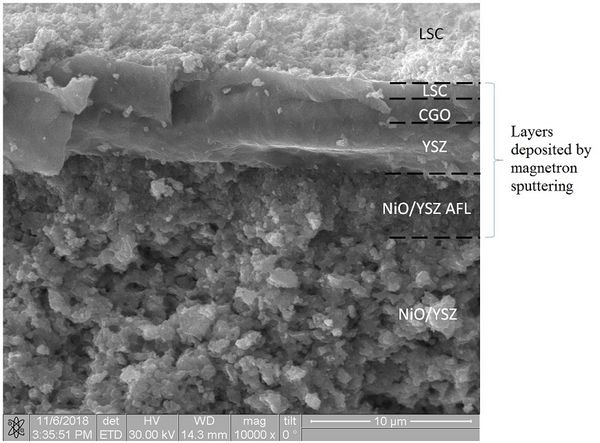
TPU scientists developed advanced technologies for manufacturing solid oxide fuel
"Solid oxide fuel cells (SOFC) based on an anode and thin electrolyte are one of the most promising and developing structures throughout the world. However, they are not produced in Russia. SRF Stepan Linnik from the Research School of High Energy Physics and his team developed ion-plasma methods for thin-film solid oxide fuel cells. The project was supported by the Russian Science Foundation. In Russia SOFCs with a supporting electrolyte layer are the most popular. For many years they have been developed at a number of RAS institutes." [...]
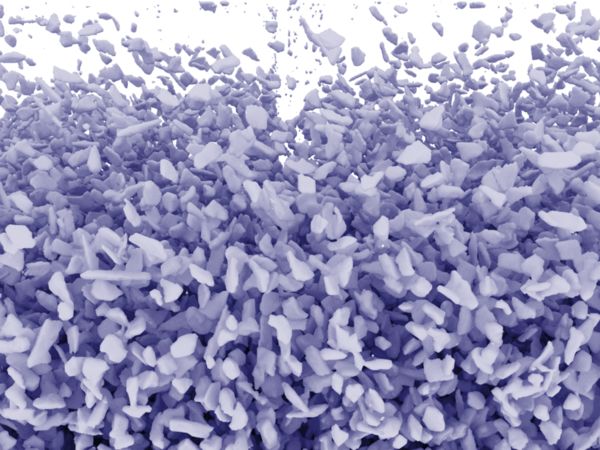
NSF funds integrated approach to 3D fracture modeling of composites
"Understanding the behavior of composite materials is important to advancing their design, since attempts to further strengthen or stiffen them can sometimes produce counterproductive results. A $545,000 grant over three years from the National Science Foundation (NSF) aims to answer some of the central questions about the microstructural mechanisms that lead to composite performance. Michael Hillman, L. Robert and Mary L. Kimball Assistant Professor of Civil and Environmental Engineering at Penn State and principal investigator on this project, has partnered with Jing Du, assistant professor of mechanical engineering at Penn State, to combine experiments and simulations in order to study composite behavior. Their focus will be on polymer-ceramic composites. “We're trying to look at what the contributing factors on the microstructural level are to toughening and stiffening these composites,” Hillman said. “Once we understand what these factors are, we hope that information can be used to design new materials in the future.” Composite materials, made from combining two or more materials, are used in everything from buildings to aircrafts because of their unique ability to provide high strength- and stiffness-to-density ratios." [...]

Learning transistor mimics the brain
"A new transistor based on organic materials has been developed by scientists at Linköping University. It has the ability to learn, and is equipped with both short-term and long-term memory. The work is a major step on the way to creating technology that mimics the human brain. Until now, brains have been unique in being able to create connections where there were none before. In a scientific article in Advanced Science, researchers from Linköping University describe a transistor that can create a new connection between an input and an output. They have incorporated the transistor into an electronic circuit that learns how to link a certain stimulus with an output signal, in the same way that a dog learns that the sound of a food bowl being prepared means that dinner is on the way." [...]
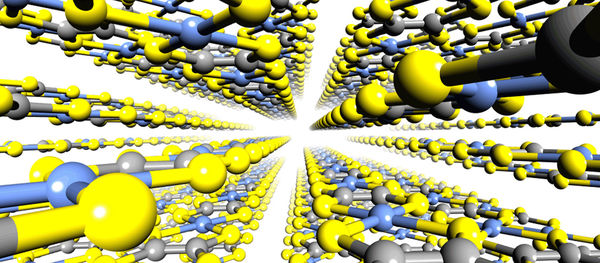
Polymer power potential
"Four organic thermoelectric polymers identified using theoretical calculations could prove valuable for harvesting energy from waste heat The mantra ‘reduce, reuse, recycle’ is increasingly pertinent. Every year, vast amounts of energy that could be captured and reused is lost through waste heat. Now, A*STAR scientists have demonstrated, through theoretical calculations, that it may be possible to fabricate thermoelectric organic polymers that can convert heat into electrical energy with high efficiency. Thermoelectric (TE) materials work by responding to temperature differences, inducing electric charge carriers to flow from the hot to the cold side of the material. TE materials are already used for powering refrigeration, and for limited power generation. An effective TE material needs to have high electrical conductivity, low thermal conductivity, and a high ‘Seebeck coefficient’ – the voltage generated per degree of temperature difference across the material." [...]
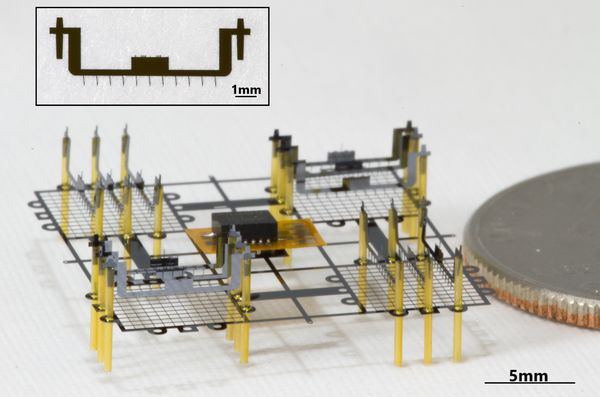
Penny-Sized Ionocraft Flies With No Moving Parts
"A drone powered by electrohydrodynamic thrust is the smallest flying robot ever made. Insect-scale flying robots are usually designed to mimic biological insects, because biological insects are masters of efficient small-scale flying. These flapping-wing micro air vehicles (FMAVS) approach the size of real insects, and we’ve seen some impressive demonstrations of bee-sized robots that can take off, hover, and even go for a swim. Making a tiny robot with flapping wings that can move in all of the degrees of freedom necessary to keep it controllable is tricky, though, requiring complicated mechanical transmissions and complicated software as well. It’s understandable why the biomimetic approach is the favored one—insects have had a couple hundred million years to work out all the kinks, and the other ways in which we’ve figured out how to get robots to fly under their own power (namely, propeller-based systems) don’t scale down to small sizes very well. But there’s another way to fly, and unlike wings or airfoils, it’s something that animals haven’t managed to come up with: electrohydrodynamic thrust, which requires no moving parts, just electricity." [...]
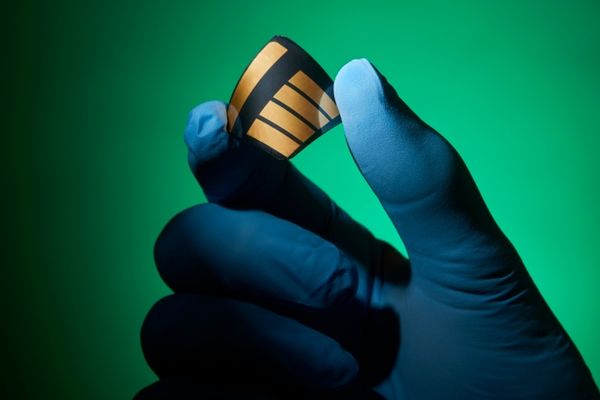
Unleashing perovskites' potential for solar cells
"New results show how varying the recipe could bring these materials closer to commercialization. Perovskites — a broad category of compounds that share a certain crystal structure — have attracted a great deal of attention as potential new solar-cell materials because of their low cost, flexibility, and relatively easy manufacturing process. But much remains unknown about the details of their structure and the effects of substituting different metals or other elements within the material. Conventional solar cells made of silicon must be processed at temperatures above 1,400 degrees Celsius, using expensive equipment that limits their potential for production scaleup. In contrast, perovskites can be processed in a liquid solution at temperatures as low as 100 degrees, using inexpensive equipment. What’s more, perovskites can be deposited on a variety of substrates, including flexible plastics, enabling a variety of new uses that would be impossible with thicker, stiffer silicon wafers." [...]

AI technology addresses parts accuracy, a major manufacturing challenge in 3D printing for $7.3 billion industry
"Automated machine learning tool could advance additive manufacturing in shape complexity, waste reduction and reduce manufacturing costs. WEST LAFAYETTE, Ind. – Imagine using machine learning to ensure that the pieces of an aircraft fit together more precisely, and can be assembled with less testing and time. That is one of the uses behind new technology being developed by researchers at Purdue University and the University of Southern California. “We’re really taking a giant leap and working on the future of manufacturing,” said Arman Sabbaghi, an assistant professor of statistics in Purdue’s College of Science, who led the research team at Purdue with support from the National Science Foundation. “We have developed automated machine learning technology to help improve additive manufacturing." [...]
Projetos Maker
Diversos Projetos interessantes.
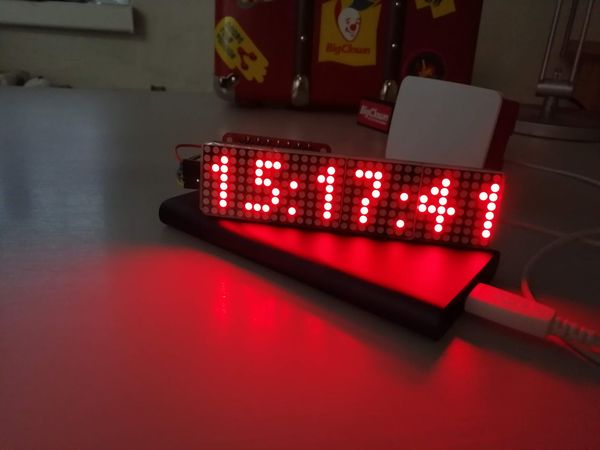
Wireless LED Matrix Display with RaspberryPi, Node-RED, MQTT
"Universal wireless display, control text and intensity over MQTT from Node-RED or your phone. Display weather, notifications, time. Story Wireless matrix LED display which you can place anwhere in your home. Connect to USB charger or power bank for real "wireless" installation. You can display messages, temperatures, subscriber count (only for Youtubers with under 6-digit subs), Bitcoins, unread e-mails... Overview The wireless LED display connects over 868 MHz FSK radio to the Raspberry Pi thanks to Radio Dongle. Raspberry Pi has pre-installed "bc-raspbian" which is Raspbian with MQTT broker, Node-RED and Radio Gateway Service." [...]

Easy Micro:Bit Rover
"In this lesson, we are using a BBC Micro:Bit to drive and control a GiggleBot with MakeCode. Before jumping into this, the GiggleBot is an easy-to-use platform that's really great for going straight into robotics without requiring prior knowledge about programming, robotics, mechanics and so on. One of the ways to program it is with MakeCode, which is an environment where the BBC Micro:Bit can be visually programmed by drag-n-dropping blocks. This allows you to program the rover in a Lego-like fashion, which is very entertaining and fun. So, nuff said, now let's get down to it! " [...]

ESP32 to ESP32 Communication Over the Internet
"A simple project template showing how to establish a connection between two ESP32-based devices. Works both in LAN and through the Internet. Story Typically connected projects has some kind of web or mobile UI. If you want to control one thing by another thing, espacially with a low latency and over the Internet that's quite hard to achieve. That is why I created this project. It's an Arduino framework template showing you how to connect two ESP32-based boards over the Internet, minimizing the latency with auto-recovery functionality in case of broken Wi-Fi connection or temporary power down of one of connected boards." [...]
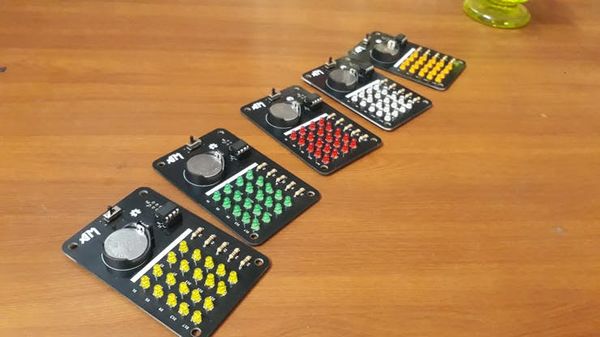
ATtiny LED Matrix Display Badge
"An ATtiny85-based badge-size PCB that can display letters and numbers. Have you ever thought of making a badge-sized PCB that can display some letters, numbers, etc... or your name? In this project, I will be showing how I built a badge-sized ATtiny85-based LED matrix display (5x4 matrix). I have used Charliplexing technique for driving 20 LEDs using ATtiny85. Charlieplexing Charliplexing is a technique for driving a multiplexed display in which relatively few I/O pins on a microcontroller are used, e.g. to drive an array of LEDS." [...]
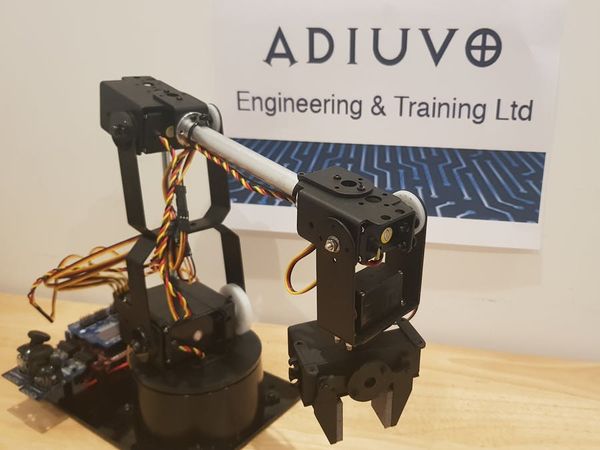
FPGA/SoC Controlled Robot Arm
"Robotics are at the leading edge of Industry 4.0, AI and the Edge revolution. Let's look at how we can create an FPGA-controlled robot arm. Story Introduction Robotics are at the forefront of the Industry 4.0 and edge revolution along with artificial intelligence and machine learning. As such I thought it would be fun to create a base robot arm project we can come back to and add in several features such as: Inverse kinematics - determine the position of the end-effector. AI / ML - object classification during operation. Networked control - enabling remote control at the edge." [...]
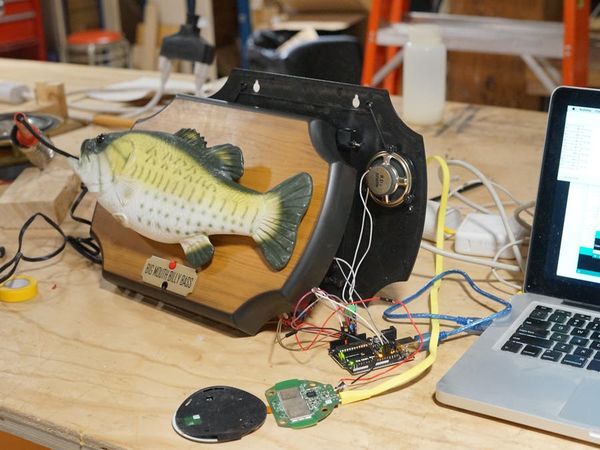
Big Mouth Billy Bass + Alexa
"Billy Bass and Alexa combine in this project to form a full bodied virtual assistant. Materials Billy Bass in the Toronto Tool Library surgery room. Big Mouth Billy Bass* Echo Dot 2nd Generation Arduino Uno Arduino Motor Driver Shield LM386 Amplifier 3.5mm Audio Cable At least 4x C Cell Batteries *This Billy Bass seems closest to mine, any should work but some may contain only two motors Billy Bass Teardown 1. Billy Bass should have some pretty obvious screws on the back. Trust your instincts and simply unscrew those (saving the screws), and pull the back off the fish. This should open up to reveal motors on the fish side, and a battery pack on the back plate." [...]
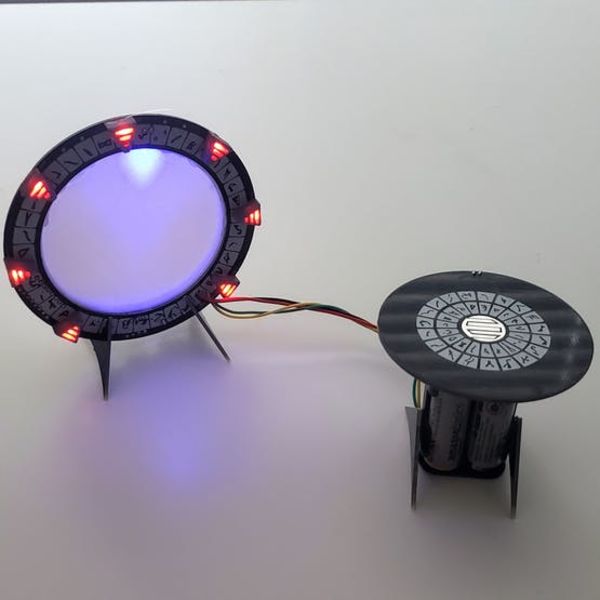
Stargate for Your Desktop - PCB Design
"It's a Stargate PCB for your desktop—engage those chevrons and establish a wormhole! Stargate SG-1 is my favorite TV show of all time—full stop. Over the past couple of months, I've been forcing my girlfriend to watch to watch the entire series. We were around season 4 when I saw that tutorials was running a PCB Contest, and it seemed like the perfect opportunity to design my very own Stargate that I could put on my desk. This project is what I came up with. It's a 4 inch diameter PCB Stargate, with accompanying DHD (that's Dial-Home Device for layman), that sits on your desk and lights up!" [...]
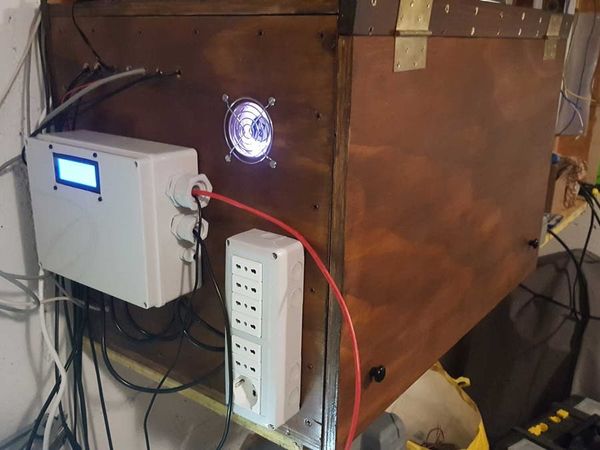
Arduino GrowBox Controller
"This GrowBox Controller handles temperature, humidity, fan and lights, and configuration is made via web server. CSV logs and remote cloud! Arduino GrowBox Controller is available on GitHub. I finally shared, with GPL3 license, the firmware I developed in theese years for my GrowBox. On my website, I already shared how I built my GrowBox, the modifications I made in time and plants growing pictures. Thanks to Arduino Mega 2560 Rev.3, this open source firmware offers a small web server for configuration, data transmission to EmonCMS instance and data logging to SD card." [...]
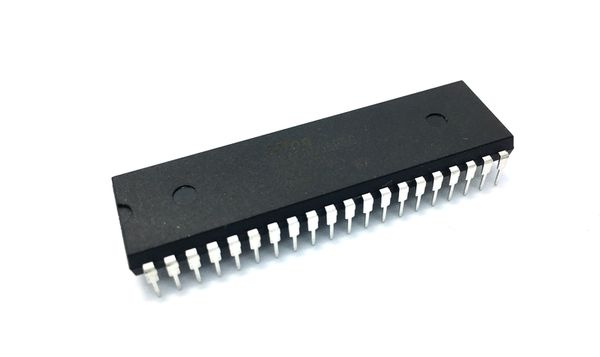
A Z80 CP/M emulator for the SAMD51
"Retro computing is very popular. It's interesting to experience what computing was like in the 80s when 8-bit processors were the standard and 64K of memory was generous. While you can get a taste of this by using an ATMega328 based board such at the venerable Arduino UNO or a Metro 328, but it's not quite the same as using a 6502 or a Z80. You can go all the way to the hardware level and get something like the RC2014 Z80 computer kit for the full experience, or you can stick with an emulator on your desktop machine. This guide takes you somewhere in-between. It looks at running a Z80 emulator on state of the art microcontroller hardware." [...]
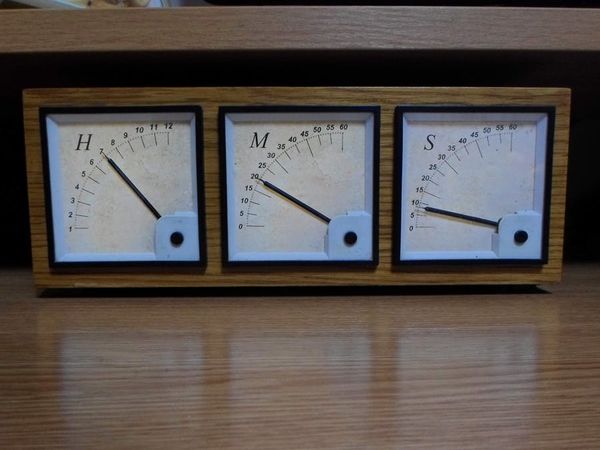
Arduino Analog Panel Meter Clock
"Nice looking wooden analog style clock with Arduino Nano and 1mA ammeters. I built this nice-looking wooden analog style clock with an Arduino Nano and 1mA ammeters. I got an idea from here. For displaying the seconds, a part of the code has been added. Also added is a part that, when running, passes through the entire scale from zero to max. value for calibrating purposes." [...]
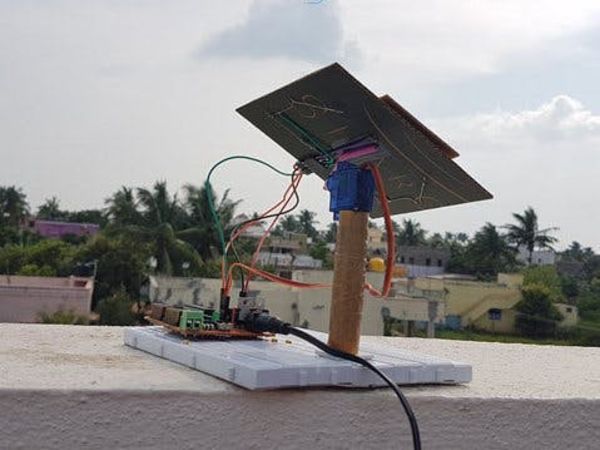
NodeMCU-Based IoT Project: Rotating Solar Panel
"Using two LDRs to get intensities in two direction and then comparing those intensities will rotate the servo motor. Story NodeMCU based project : Rotating Solar Panel In this project, we will see a simple Sun Tracking Solar Panel circuit which will track the Sun and position the solar panels accordingly. Introduction As the non renewable energy resources are decreasing, use of renewable resources for producing electricity is increasing. Solar panels are becoming more popular day by day. Solar panel absorbs the energy from the Sun, converts it into electrical energy and stores the energy in a battery. This energy can be utilized when required or can be used as a direct alternative to the grid supply." [...]
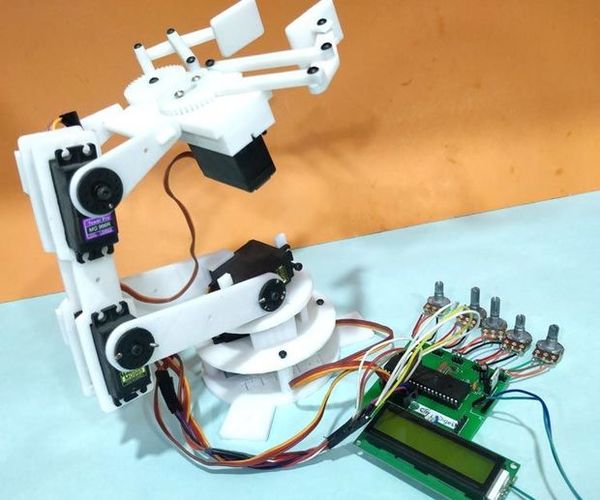
PIC Microcontroller Based Robotic Arm
"From the assembly line of automobile manufacturing industries to the telesurgery robots in space, Robotic Arms are to be found everywhere. The mechanisms of these robots are similar to a human which can be programmed for similar function and increased capabilities. They can be used to perform repeated actions faster and accurate than humans or can be used in harsh environments without risking human life. We have already built a Record and Play Robotic Arm using Arduino which could be trained to do a particular task and made to repeat forever. In this tutorial, we will use the industry standard PIC16F877A 8-bit Microcontroller to control the same robotic arm with potentiometers. The challenge with this project is that PIC16F877A has only two PWN capable pins, but we need to control about 5 servo motors for our robot which requires 5 individual PWM pins." [...]
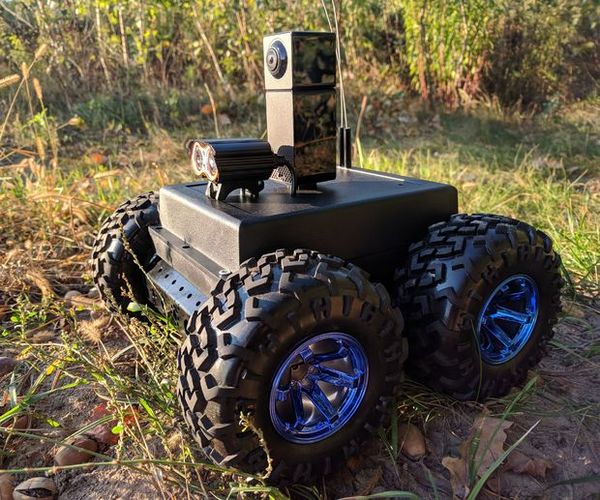
4WD Security Robot
"The main goal of this project was to build a security mobile robot capable of moving and collect video data in rough terrain. Such a robot could be used to patrol the surroundings around your house or hard to reach and hazardous places. The robot can be used for night patrols and inspections because it has been equipped with a powerful reflector which illuminates the area around it. It is equipped with 2 cameras and remote control with a range over 400 meters. It gives you great opportunities to protect your property while sitting comfortably at home. Robot Parameters - External dimensions (LxWxH): 266x260x235 mm - Total weight 3.0 kg - Ground clearance: 40 mm" [...]

Shaking Arduino Dice
"One year ago I built a simple Arduino dice with my son. We have learned a lot in the meantime and it's time for an update... Story About a year ago my son and I built an electronic dice with an Arduino and a few LEDs. This is still an ideal project for beginners. We have learned a lot this year, so it's high time for an update. The dice is still a perfect starter project. The function is clear to everyone and it is easy to understand the different areas: microcontroller, simple electronics and coding." [...]
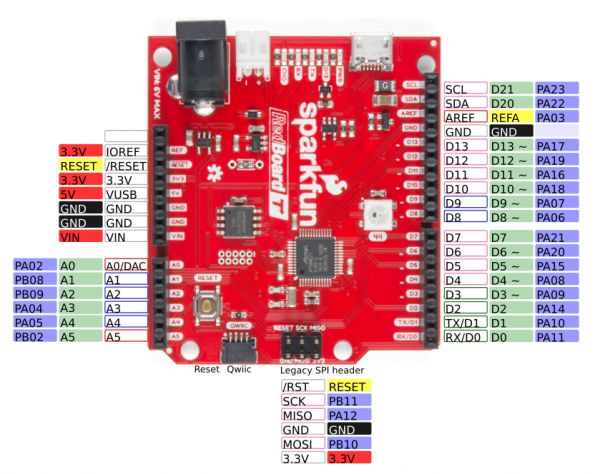
Adding More SERCOM Ports for SAMD Boards
"Introduction SERCOM (Serial Communication) is a multiplexed serial configuration used on the SAMD21, SAMD51 and other boards. It allows you to select various serial functions for most of your pins. For example, the ATmega328 which has UART (RX/TX) on one pair of pins, I2C (SDA/SCL) on another set, and SPI (MOSI, MISO, SCK) on another set. The SAMD21 has 5 different internal ports which you can configure to use any combination of UART, I2C, and SPI. The SAMD21 and SAMD51 boards are becoming increasingly popular in part because of this feature. But how do you do it?" [...]
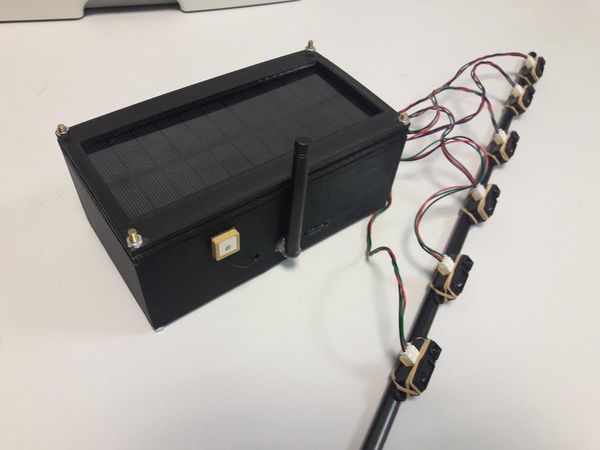
Holebot (Pothole Detector)
"A fully autonomous pothole detector that updates a visual backend in real-time, and also provides detailed data stored on an SD card. Story Each year, Renault hosts a contest of hacking its Twizy platform (a design based on an electric urban vehicle). We participated in that contest (via our university, Polytech Sorbonne) and came up with the idea of hacking the platform to make a pothole detection vehicle, that can update a map with the positions of the potholes in real time. Here's the promotional video we made about it (there are subtitles in English): So how does it work? Its array of 6 infrared sensors mounted under the vehicle pointing downwards detect changes in distance between the vehicle and the road, thus detecting potholes. The system's accelerometer can also detect the potholes and abrupt shocks the vehicle experiences due to abnormal vertical variations." [...]

Solar Powered Weather Station
"To expand my microcontroller and programming knowledge I have decided to try and make a Solar Powered Weather Station. My goal is to record parameters like: Temperature Humidity Air pressure Air quality (something to do with CO or CO2) I then hope to send (wirelessly) the data to a base station and log/display it on a simple website. To make things interesting I also aim to power the data gathering station from a large supercapacitor (~100F), and in keeping with my solar tradition the supercapacitor will be charged from a solar-cell. Just like with my last project I want this thing to last for a good 20-40years with minimal intervention, meaning I will also have to dive into the wonderful world of watchdogs as well as structure my code to handle glitches properly. With all that said here is what I have so far: MCU + Tx/Rx After a bit of research I decided to go with the Nordic Semiconductor nRF52832 as doing so will allow me to have an MCU + Tx/Rx capability all on the one chip. Also this chip supports Bluetooth 5 so is ideal for this low power & data rate application: Sensors To cover temperature, humidity, & air pressure I will be using the trusty Bosch BME280." [...]
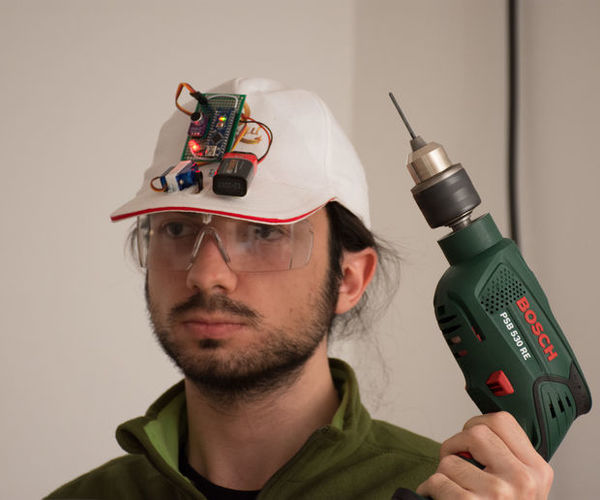
Eye Guardian: Sound Triggered Eye Protection
"Eye Guardian is an Arduino powered, High-Decibel continuous sound triggered eye protection wear. It detects heavy equipment sound and lowers protective eye goggles while the equipment is in use. Outline In the first step, I will explain the Inspiration&Idea behind this project. Next, I will give you a Tools&Parts list that I have used to build this. Then I will explain the design choices I made and give you a guide to 3D print the parts needed for this instructable. After giving you a step by step assembly guide on the electronics and hat assembly I will end the instructable with a troubleshooting guide and a What's Next section where I will discuss what can be added or changed in the future." [...]

Cancellino
"Control your gate (or whatever you want) for free using a simple phone call. Story This project shows how to use an Arduino to receive a call and compare the calling number with numbers saved in the microSD card, without answering! This solution works also with a plain SIM with no data plan. It's also possibile to save new authorized numbers via SMS. What you need The project is based on an Arduino MKR GSM 1400, an antenna, a LiPo battery pack, an Arduino MKR MEM shield, a microSD card, an Arduino MKR Connector Carrier, a Grove Relay Module, one SIM card, and of course, a phone! The Arduino MKR GSM 1400 executes the sketch and supports the GSM connection that allows the call and SMS receiving features required by our project; Antenna and battery pack are respectively used to allow the connection to the cellular network with a good signal and to power the device when other power supplies are not available; The Arduino MKR MEM shield and microSD card (formatted as FAT16 or FAT32) are used to store a file with all the authorized phone numbers; Arduino MKR Connector Carrier is used to easily connect other electronics module as the Grove Relay Module; The SIM card is required to access the GSM network; PIN, is required to use the sim card." [...]
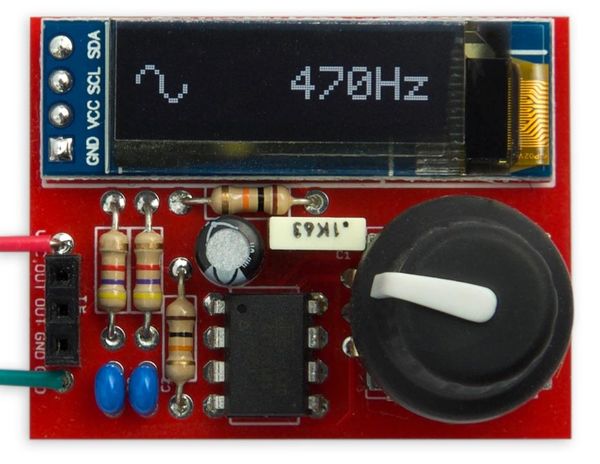
Tiny Function Generator PCB
"This is a PCB version of my earlier Tiny Function Generator project based on an ATtiny85. It uses Direct Digital Synthesis to generate sine, triangle, sawtooth, square, and rectangular waves, a pulse train, and noise. The frequency can be adjusted using a rotary encoder between 1Hz and 5kHz in steps of 1Hz, and the selected waveform and frequency is displayed on an OLED display: The original article Tiny Function Generator included seven waveforms, and the follow-up article Tiny Function Generator Sine Wave added the sine wave. " [...]
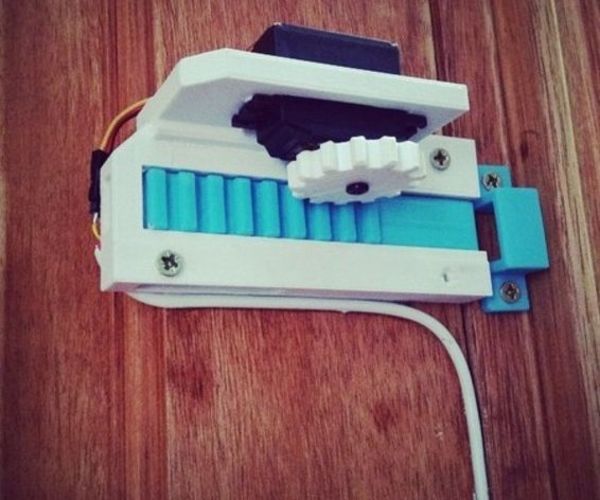
RFID Lock System Using Arduino
"Hello everyone, This is my first instructable and was presented by Judhi Prasetyo. The workshop was hosted by Assembly , where I am working as an intern and its one of the best place to work if you are a maker. Coming back to the RFID lock system, I will explain to you how it works. Overview:- We use RFID tag and reader in this system.Now every tag has a unique codewhen you place the tag on the reader which is connected to ArduinoThe reader decodes the radio frequency code to multiple characters and sends it to ArduinoArduino already has stored RF code in its memory which is written by usArduino checks if the RF code received matched to the code in its memoryIf it matches then servomotor opens the lock with rack and pinion mechanism that converts rotation motion to linear motion" [...]
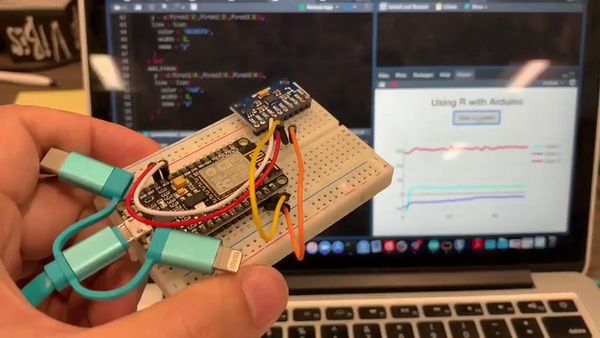
Connecting Arduino Chips with R
"Sensors are fun. They are small electronic chips that can sense this world. Our smartphones have a bunch of sensors, like gyroscope and accelerometer, but you can also connect these sensors with either an Arduino or a Raspberry Pi. (In this post, I won’t talk about Raspberry Pi because although I have one Raspberry Pi at home, the only thing I did with that board so far is to get it out of box… 😳) As an open-source project, Arduino allows people to write C-like code to program a microcontroller. It also has an IDE, which comes with a Serial Monitor. As a data scientist, from the moment I saw the data inside the Serial Monitor, I began to wonder if we can get the data out of this box and maybe visualize them in R, where I have a lot more tools to generate better visualizations." [...]
That's all Folks!


